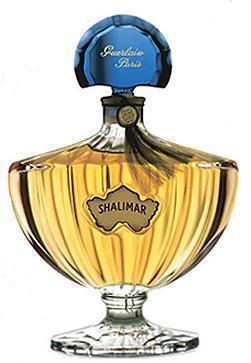Released 1925 Website www.guerlain.com | ||
 | ||
Type Oriental fragrance: Floral and Amber-woody scent. | ||
Shalimar is a women's fragrance originally created by Jacques Guerlain in 1921, as a classic soft amber (Oriental) parfum, and currently produced by Guerlain.
Contents
History
Popular for 90 years, Shalimar was created in 1921, and re-released in 1925, by Jacques Guerlain in a bottle designed by Raymond Guerlain and made by Cristalleries de Baccarat (bottle design # 597) and launched at the Decorative Arts Exhibition as an antidote to The Great Depression.
According to Elisabeth Barille, "while examining a sample of vanillin, Jacques Guerlain suddenly poured the entire contents into a nearby bottle of Jicky, just to see what would happen." The result: Shalimar.
Jacques Guerlain was inspired by Mumtaz Mahal, the woman for whom the Taj Mahal was built. Mughal Emperor Shah Jahan's love for Mumtaz Mahal, his favourite wife, was so great that he built her the Garden of Shalimar in Lahore, Pakistan (and indeed, the Taj Mahal).
The meaning of the word Shalimar remains a mystery, but it is certainly of Arabic or Persian origin as asserted by Anna Suvorova in her book Lahore: Topophilia of Space and Place.
In 1985, it was repackaged and presented encased in a Lucite box to commemorate the 60th anniversary of its original launch.
In 2004, Guerlain issued Shalimar Light by perfumer Mathilde Laurent. However, Shalimar Light was taken off the market and replaced by Eau de Shalimar in 2008.
Shalimar itself is currently produced in Shalimar Extract, Eau de Parfum, Eau de Toilette, Eau de Cologne, and Fleur de Shalimar Edition.
Guerlain also markets Shalimar Parfum Initial, which has a different formula, color and fragrance than Shalimar.
Shalimar is preserved in its original 1925 formulation in the archives of the Osmothèque, donated by Jean-Paul Guerlain.
Scent
The fragrance can be described as vanilla, powdery and sweet. The fragrance contains bergamot, lemon, jasmine, rose, iris, incense, opopanax, tonka bean and vanilla. It is considered to be an Oriental perfume (see Fragrance Wheel); spicy perfumes were popular during Shalimar's conception. The top note of the fragrance is bergamot. The middle notes are iris and rose. The base note is vanilla.
Marketing
Over the years, Shalimar has had numerous ad campaigns.
In the 1950s, the illustrations created for Shalimar and other Guerlain perfumes, for the classic French advertising posters of the era, were some of the greatest works by the major illustrators of the day, such as Lyse Darcy, Cassandre, and so on.
In Popular Culture
Shalimar is mentioned in the songs "Forty Shades of Green" by Johnny Cash and "Madame George" by Van Morrison.
In "House Arrest" (Season 2 Episode 11) of "The Sopranos" HBO, Junior Soprano mentions to his doctor he sent a bottle to a medical assistant (Tracy) who had checked on him at his home after having a stent placed.
In the 1989 Gene Wilder and Richard Pryor movie, "See No Evil, Hear No Evil", Richard Pryor's blind character identifies the villainess played by Joan Severance by her "beautiful smell", "Shalimar".
In the 1971 thriller The Mephisto Waltz Shalimar is the perfume favored by Jacqueline Bisset's character named Paula. At the film's conclusion when Paula's soul has been transferred in the body of Roxanne (Barbara Parkins) the character of Duncan Ely who is unaware of the change remarks to Roxanne, "isn't that the perfume worn by our late little housewife ?"
In the movie "The Four Seasons", directed and starring Alan Alda. Shalimar is given as a gift.
Shalimar is mentioned during the NCIS S11 E12. Ducky is performing an autopsy and asks Gibbs to take a whiff of the deceased. He tells him that the smell is expensive.
